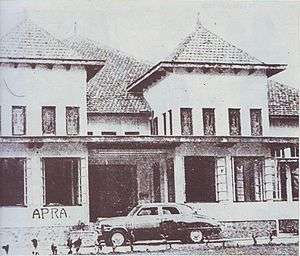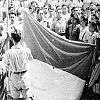APRA coup d'état
The APRA coup d'état was a coup d'état by Raymond Westerling's Legion of Ratu Adil (APRA) to capture Bandung and Jakarta, and to overthrow Sukarno’s unitary Republic of Indonesia. Westerling was a demobilised Dutch Captain of the KNIL (Royal Netherlands East Indies Army), who sought to preserve the federal Republic of the United States of Indonesia, which retained the support of the Netherlands and various minority elements. Westerling's forces succeeded in capturing Bandung in the early hours of 23 January 1950.
| APRA coup d'état | |||||||
|---|---|---|---|---|---|---|---|
| Part of the Indonesian National Revolution | |||||||
 Siliwangi Division headquarters occupied by the APRA during the coup. | |||||||
| |||||||
| Belligerents | |||||||
|
| |||||||
| Commanders and leaders | |||||||
| Captain Westerling |
Colonel Sadikin Major General Engles | ||||||
| Units involved | |||||||
| Siliwangi Division[1] | |||||||
| Strength | |||||||
| 2,000 APRA troops[2] | 4,500 TNI troops[2] | ||||||
| Casualties and losses | |||||||
| ≈100 killed[2] | |||||||
Simultaneously, the APRA infiltrated Jakarta as part of a coup d’état to overthrow the RUSI Cabinet.[1] Their plan was to arrest and assassinate several prominent Republican figures including the Defence Minister Sultan Hamengkubuwono IX and Secretary-General Ali Budiardjo. However, Westerling's forces in Jakarta were killed or captured by the Indonesian army and police forces. The APRA was forced out of Bandung, while Westerling escaped to Singapore. After a mopping up campaign the Legion of Ratu Adil had ceased to function in February 1950. The coup d'état led to the downfall of Sultan Hamid II and accelerated the integration of the RUSI into the Republic by 17 August 1950.[4]
Rise of the APRA
Prior to the transfer of sovereignty on 27 December 1949, a RUSI Cabinet consisting of both Republican and Federalist members was formed on 17 December 1949. This Cabinet was headed by Prime Minister Mohammad Hatta and included 11 Republicans and five Federalists including the pro-Dutch Sultan Hamid II. Ultimately, this federal government was short-lived due to conflicting differences between the Republicans and the Federalists as well as growing popular support for a unitary state.[5]
Growing tensions between the Republicans and Federalists prompted Hamid II to conspire with the former commander of the DST (Depot Special Forces) commando unit Raymond Westerling to organize an anti-Republican coup d’état which would ensure a federal Republic of the United States of Indonesia.[4] By January 1950, Westerling had built up a militia force known as Angkatan Perang Ratu Adil (APRA, Legion of Ratu Adil). Raymond Westerling stated that the APRA counted 22,000 men. American historian George Kahin estimates it was about 2,000 men.[4]
The APRA comprised various Republican elements including defectors from the Indonesian army, Islamic and communist battle groups. The Legion was further augmented by elements of the KNIL, Royal Netherlands Army, Westerling's old commando unit and several sympathetic Dutch nationals including two police inspectors. The Republican government attempted to negotiate with Westerling by offering to pay him US$100,000 in exchange for renouncing his revolutionary activities, but Westerling rejected the offer.[6]
On 5 January 1950, Westerling sent an ultimatum to the government of Jakarta. His demands were the recognition of the APRA as the official army of the state of Pasundan and unconditional respect for the autonomy of the federal states. Westerling added that if the answer was not positive, he could not be held responsible for the outbreak of large-scale fighting by the APRA. With no reply to his ultimatum, Westerling started the coup in the night of 22–23 January, a month after international recognition of the Republic of Indonesia.[7]
Attacks against Bandung and Jakarta
Westerling's planned coup d’état involved the near-simultaneous capture of Bandung and Jakarta, followed by the capture of Buitenzorg (modern-day Bogor) where some minor government departments were based. On 22 January, Westerling's troops would infiltrate Bandung on board trucks, disguised as members of the Tentara Nasional Indonesia (TNI). At 10 pm, they would seize ammunition stocks from the old KNIL arms depot in Bandung and then dispatch them to a rendezvous point 15 miles away for delivery to Djakarta by 11 pm. At 5 am on 23 January, APRA forces based in nearby Tjimahi would capture strategic locations like military bases, police stations, and government buildings and communications facilities throughout Bandung and Jakarta.[1]
At dawn, about 520 APRA soldiers entered Bandung. However, the Siliwangi Division, which was encamped in the city, had been forewarned of Westerling's plans. A motorized unit was sent to intercept the Legion, but was quickly defeated. Advancing through Bandung, the APRA captured key locations including the TNI's headquarters and the Siliwangi barracks. Within an hour, they had secured the city center and eliminated all resistance. TNI Lieutenant Colonel Adolf Lembong and 93 other Indonesian soldiers and officers were killed. The majority of the TNI forces were taken by surprise and there were reports of soldiers discarding their uniforms and fleeing. TNI Colonel Erie Sudeweo sought refuge in the Dutch barracks.[8]
However, the second phase of the coup d'état collapsed since the majority of the KNIL's commanders cooperated with the Indonesian government and refused to support Westerling's actions. A Dutch officer discovered the unloading of ammunition from the Bandung arms depot into trucks of the APRA. Due to this development, the ammunitions convoy did not arrive in the Republican capital Jakarta at 11 PM as planned. Westerling's Legion was unable to launch its scheduled attack at 5 AM on 23 January. There had been plans to seize the presidential palace, army barracks and to arrest Republican politicians including Sukarno, Hatta, Hamengkubuwono IX and Ali Budiardjo. Unable to find any ammunition, Westerling was forced to abort his attack by 6 AM. With the coup attempt in tatters, the APRA retreated from Bandung after negotiations with KNIL Major General Edu Engles. By 5 PM Republican forces under Sadikin had re-established control over Bandung.[9]
Aftermath of the coup
In the following weeks several small APRA units were defeated in a mopping up campaign by the Indonesian army and police. The Legion of Ratu Adil had ceased to function in February 1950. The attempted coup d'état increased public agitation for the dissolution of the federal system.[4] Westerling escaped with the help of the Dutch government to Singapore. Despite attempts by the Indonesian government to extradite him, he lived in exile in the Netherlands until his death in 1987.
By April 5, several key conspirators including Sultan Hamid II had been arrested by the Republican authorities. On April 19, Hamid II confessed to his involvement in the botched Jakarta coup and to planning a second attack on Parliament scheduled for February 15. Due to the presence of RUSI troops, the attack had been aborted. The role of the Pasundan government in the coup led to its dissolution by February 10, further undermining the federal structure. By late March 1950, Hamid's West Kalimantan was one of the four remaining federal states in the United States of Indonesia.[4]
Hamid's role in the coup led to increased agitation in West Kalimantan for its integration into the Republic of Indonesia. Following a fact-finding mission by the Government Commission, the RUSI House of Representatives voted, by a margin of fifty votes to one, to merge West Kalimantan into the Republic of Indonesia.[3] Following clashes with demobilized KNIL troops under Andi Aziz in Makassar and the attempted secession of an Ambonese Republic of South Moluccas, the federal United States of Indonesia was dissolved on 17 August 1950, turning Indonesia into a unitary state dominated by the central government in Jakarta.[3]
Notes
- Westerling (1952), p. 180-81
- Westerling (1952), p. 189
- Kahin (1952), p. 456
- Kahin (1952), p. 454-56
- Kahin (1952), p. 448-48
- Westerling (1952), p. 198
- De Moor (1999) 413-36
- De Moor (1999) p. 437-72
- De Moor (1999), p. 473-79
References
- Kahin, George McTurnan (1952). Nationalism and Revolution in Indonesia. Ithaca, N.Y.: Cornell University Press. ISBN 0-8014-9108-8.
- De Moor, Jaap A. (1999). Westerling's Oorlog: Indonesië 1945-1950. Amsterdam: Balans. ISBN 90-5018-425-1 ISBN 9789050184250.
- Westerling, Raymond Paul Pierre (1952). Mes aventures en Indonesie (in French). – translated from the French to English by Waverley Root as – Challenge to terror. London: W. Kimber.
Further reading
- De Jong, Louis (1988). Het Koninkrijk der Nederlanden in de Tweede Wereldoorlog, volume 12. Amsterdam: NIOD. ISBN 90-12-06880-0.
- Venner, Dominique (1977). Westerling: Guérilla Story. Paris: Hachette. ISBN 2-01-002908-9 ISBN 9782010029080.
External links
- Westerling biography in the Dutch language
- Images of Westerling, his troops, his passport and gravestone
- Summary of Dutch publications about Westerling and his actions in Indonesia
